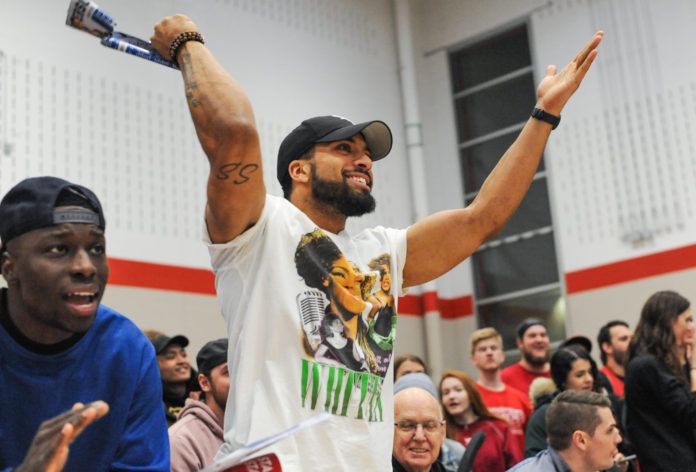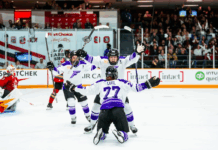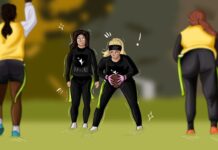Two years ago, fresh off being selected in the first round by the Edmonton Eskimos in the 2017 Canadian Football League (CFL) draft, Nathaniel Behar was absent from his first CFL training camp due to a contract holdout.
Nearly a week into the dispute, Behar–who is best known for catching the game-winning touchdown in the dying seconds of the 2014 Panda Game–decided to see what people were saying on Twitter. The results were unexpected.
“It weighed on me,” Behar said regarding the effect people’s tweets had on his life at the time. “My workouts went to shit. It was a lot to see people I’d never met, to see people I might never meet, in general, wish the very worst for me.”
The comments piled up as he scrolled further down his Twitter feed, and they weren’t getting any better.
“I hope this kid blows his ACL out,” Behar recalls one tweet saying. “I hope he never steps foot on the field,” another one reads. “I hope they just keep the contract so he can never play a down of professional football.”
With social media becoming a crucial component of current and former student athletes’ lives, many players have found it difficult to stay focused and keep their mental health in check.
Despite the competitive edge outlets such as Instagram, Twitter, and Facebook, have at providing student athletes assistance in everything from sport-specific tutorials to training videos, many opt to keep it entirely hidden so they can remain at peak-condition come game day.
“You’re reading all this stuff about you, people that have never seen you… sitting around talking about you and how badly they want your career to end for reasons they have no idea about,” Behar said. “It’s kind of jarring.”
Behar is not alone.
According to a 2016 U.S. report by Fieldhouse Media which surveyed over 1,300 National Collegiate Athletic Association (NCAA) student athletes, 84 percent reported having a Twitter account. Of those athletes, 17 per cent stated they had received hateful or critical tweets from other users.
The study also showed student athletes reflected on the feedback they received through social media, mainly at practice when working to improve on aspects which were scrutinized. Some athletes even reported tuning out thoughts of social media during practices and games.
According to Dr. Jim Taylor, an adjunct professor at the University of San Francisco and an expert on sports psychology, the use of smartphones and social media has become an addiction which can “have the same neurochemical effect as drugs, alcohol and gambling,” on everyone, including student athletes.
Throughout his time working in the sports psychology field with Olympic, professional, collegiate, and junior athletes in the U.S., Taylor has seen how social media can negatively impact a student athlete’s on-field performance and ability to focus.
“It creates pressure because now they’re worried about what other people think of them,” Taylor said. “So if they have a bad game they check their social media–what are people saying? So that can create anxiety and create stress. It can hurt confidence.”
According to a 2017 study conducted by the Journal of Sports Sciences, nearly 32 per cent of the athletes surveyed used Facebook during competition while 68 per cent accessed Facebook within two hours before competing.
The survey was conducted on 298 athletes aged 18 and over from 13 different countries varying from the local, national and international level to determine the relationship between Facebook and an athlete’s sports anxiety.
It’s an issue which Carleton infielder, and former NCAA Division II baseball player Justin Emond made a routine of avoiding. Prior to coming to Carleton in the fall of 2019, Emond played at Herkimer County Community College in Herkimer, N.Y., and Carson NewmanUniversity in Jefferson City, Tenn., from 2016 to 2018.
After returning home to Russell, Ont., in 2018 following his stint at Carson Newman, Emond made an effort to delete a lot of his social media after realizing the addictive nature it created in his life.
Throughout the early years of his university career, Emond says he traditionally checked his phone immediately after games–something he says many student athletes are guilty of doing.
“I think social media in general just diverts our focus… I think that it’s taking our focus right off the game right away.Whereas maybe if smartphones didn’t exist, after the game you might say ‘okay, well, maybe go get some more reps in, maybe practice a little more,’” Emond said.
During high school, however, Emond’s focus was turned more towards getting recruited by colleges than being on the baseball field.
As a senior at St. Thomas Aquinas Secondary School, Emond was fielding very few offers from post-secondary recruiters during the season. The struggle eventually led to stress and anxiety as he watched other high school baseball players announce their commitments to universities and colleges.
“Everyone posts when they accept their offer from a university online… They all post it on the internet, on Twitter, and someone that’s not really getting those offers are seeing all these people commit to schools can probably get disappointed.” – Justin emond, carleton varsity baseball
Canadian quarterback Nathan Rourke, who is the starting quarterback for the NCAA’s Ohio University Bobcats, knows the challenges social media can create for student athletes both in Canada and theU.S.
Rourke, a back-to-back recipient of the Jon Cornish Award for being the top Canadian football player in the NCAA, says it’s taken some time to adapt to the American media landscape but understands it comes with the gig of being a high-profile student athlete.
“I think that Canadian sports isn’t as big, it’s getting there but it’s not what it is in the [U.S.],” Rourke said. “It’s a bigger deal and so what student athletes say and what they do on social media is blown up just that much more.”
Since coming to Ohio in 2017, where he is now playing his senior season for theBobcats, Rourke has tried to limit the impact social media can have on his mental preparation during the season by making his accounts private from non-followers.
“There’s a lot of things that people have opinions [on] that are way off base, based off limited knowledge, and then there’s things that are just there to kind of boost your ego,” Rourke said of the out-side noise created by social media.
“I try to stay away from both because I want to stay level-headed and just kind of in a neutral position.”
As researchers continue to develop in-formation on the psychological impact of social media, Taylor says he expects there could be a backlash from youth and student athletes in the form of “social media breaks,” but admits it remains a “very foggy landscape.”
Two years after experiencing the Twitter incident, Behar has since tuned out the noise.
He continues to remain active on social media, including his Twitter account which has more than 1,500 followers.
After signing with the Ottawa Redblacks as a free-agent leading into the 2019 season, Behar chose to train at Carleton’s facilities this past summer to help him get ready.
Every now and then, his former coach brings him in to talk to current players in the program. The impact of social media is still prevalent.
“You can tell that everybody is kind of just living off the same hype machine, trying to be the same person,” Behar said.
“Everyone’s trying to be the same as whoever is most [popular] on Instagram right now, and it’s kind of hard to watch.”
Feature image by Tim Austen.






